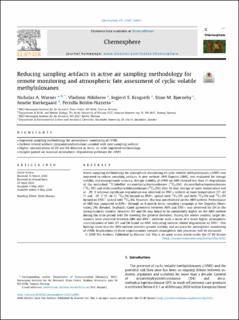| dc.contributor.author | Warner, Nicholas Alexander | |
| dc.contributor.author | Nikiforov, Vladimir | |
| dc.contributor.author | Krogseth, Ingjerd Sunde | |
| dc.contributor.author | Bjørneby, Stine Marie | |
| dc.contributor.author | Kierkegaard, Amelie | |
| dc.contributor.author | Bohlin-Nizzetto, Pernilla | |
| dc.date.accessioned | 2020-05-29T10:12:58Z | |
| dc.date.available | 2020-05-29T10:12:58Z | |
| dc.date.created | 2020-05-05T11:33:54Z | |
| dc.date.issued | 2020 | |
| dc.identifier.citation | Chemosphere. 2020, 255, 126967. | en_US |
| dc.identifier.issn | 0045-6535 | |
| dc.identifier.uri | https://hdl.handle.net/11250/2656000 | |
| dc.description.abstract | Active sampling methodology for atmospheric monitoring of cyclic volatile methylsiloxanes (cVMS) was improved to reduce sampling artifacts. A new sorbent, ABN Express (ABN), was evaluated for storage stability and measurement accuracy. Storage stability of cVMS on ABN showed less than 1% degradation of the individual 13C-labelled octamethylcyclotetrasiloxane (13C4-D4), decamethylcyclopentasiloxane (13C5-D5) and dodecamethylcyclohexasiloxane (13C6-D6) after 14 days storage at room temperature and at −20 °C whereas significant degradation was observed on ENV + sorbent at room temperature (37–62%) and −20 °C (9–16%). 13C4-D4 formed on ENV + spiked with 13C5-D5, and both 13C4-D4 and 13C5-D5 formed on ENV + spiked with 13C6-D6. However, this was not observed on the ABN sorbent. Performance of ABN Express was compared to ENV + through an 8-month Arctic sampling campaign at the Zeppelin Observatory (Ny Ålesund, Svalbard). Good agreement between ABN and ENV+ was observed for D4 in the spring/summer months. However, D5 and D6 was found to be consistently higher on the ABN sorbent during this time period with D6 showing the greatest deviation. During the winter months, larger deviations were observed between ABN and ENV + sorbents with a factor of 4 times higher atmospheric concentrations of both D5 and D6 found on ABN; indicating sorbent related degradation on ENV+. Our findings show that the ABN sorbent provides greater stability and accuracy for atmospheric monitoring of cVMS. Implications of these improvements towards atmospheric fate processes will be discussed. | en_US |
| dc.language.iso | eng | en_US |
| dc.rights | Navngivelse 4.0 Internasjonal | * |
| dc.rights.uri | http://creativecommons.org/licenses/by/4.0/deed.no | * |
| dc.title | Reducing sampling artifacts in active air sampling methodology for remote monitoring and atmospheric fate assessment of cyclic volatile methylsiloxanes | en_US |
| dc.type | Peer reviewed | en_US |
| dc.type | Journal article | en_US |
| dc.description.version | publishedVersion | en_US |
| dc.rights.holder | © 2020 The Authors. Published by Elsevier Ltd. | en_US |
| dc.source.pagenumber | 8 | en_US |
| dc.source.volume | 255 | en_US |
| dc.source.journal | Chemosphere | en_US |
| dc.identifier.doi | 10.1016/j.chemosphere.2020.126967 | |
| dc.identifier.cristin | 1809436 | |
| dc.relation.project | Norges forskningsråd: 117031 | en_US |
| dc.relation.project | Miljødirektoratet: 16078187 | en_US |
| dc.relation.project | NILU - Norsk institutt for luftforskning: 110035 | en_US |
| cristin.ispublished | true | |
| cristin.fulltext | original | |
| cristin.qualitycode | 1 | |

